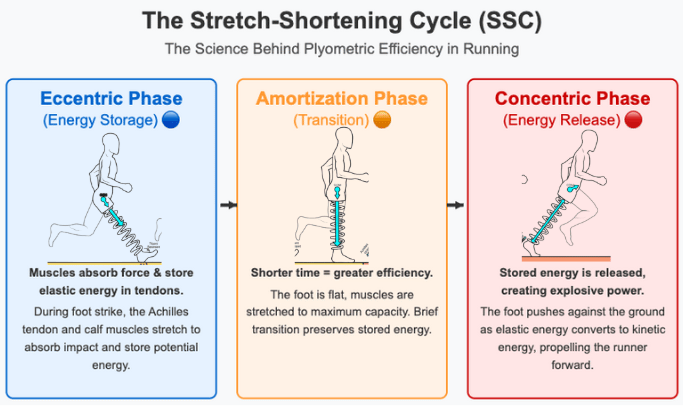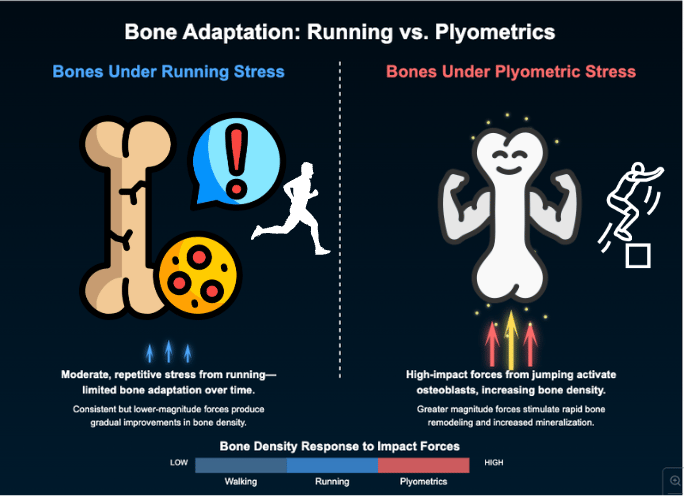Shave 6 Minutes Off Your Marathon Without Running More—Here’s How
Estimated read time: 3.37 minutes (about the time it takes for my dog Augie to demolish a new chew toy 🐶)
Hey Performance Nerds! Jonah here. 🤓
Most runners think piling on more miles is the key to getting faster. But one missing training method could be the secret to make you faster prevent injuries
Spoiler: It’s not more miles. It’s plyometric training.
🔬 Studies show that runners who add plyos improve race times by 2.7%—that’s nearly 6 minutes off a 3:30 marathon!
Here's what we're jumping into today (see what I did there 😉):
🧪 Why plyometrics make you a more efficient runner
🦴 How jumping strengthens your bones (and prevents injuries!)
📋 ✅ A safe, 8-week plyometric progression plan to boost performance (without wrecking your legs).

The Science of Plyometrics: Why Jumping Makes You Faster 🧪
Want to cut your race time without adding more miles?
A recent study found that runners who reduced mileage but added twice-weekly plyos saw bigger improvements in their 10K times than those who just kept logging miles.
Here’s why: Plyometrics supercharge your running economy—helping you run the same pace with less effort.
🏃 Your body relies on the stretch-shortening cycle (SSC) while running:
1️⃣ Eccentric phase – Your foot hits the ground, muscles absorb impact, storing elastic energy.
2️⃣ Amortization phase – A quick transition (shorter time = greater efficiency).
3️⃣ Concentric phase – You push off, releasing stored energy, propelling forward.

Your legs are basically giant springs—load 'em, launch 'em, and hope for the best! 🚀🔬
(It's like when Augie spots a squirrel—Eccentric Phase: crouch. Amortization Phase: split-second pause. Concentric Phase: pure, unhinged liftoff. 🐶💨)
💡 Faster SSC = More power, less effort, and better running efficiency.
Think of your legs like rubber bands—the better they stretch and snap back, the more efficient your stride becomes.
👉 Traditional endurance running doesn’t fully optimize the SSC. You need explosive movements (like plyos) to unlock that efficiency.
Bone-Building Benefits: Why Runners Need Impact 🦴
🚨 Running alone isn’t enough to protect you from bone stress injuries.
Long-distance running provides moderate, repetitive forces, but your bones need high-impact loading to truly get stronger.
🔬 The Science:
✔ High-impact jumps create short, intense loading on bones.
✔ This stimulates osteoblasts (bone-building cells), increasing bone density and reducing stress fracture risk.
✔ Runners who do plyos have stronger bones than those who only run.

Want bones of steel? Stop just jogging and start jumping! 🦴💪
(Meanwhile, Augie’s bones are already elite—from years of launching off the couch like a caffeinated kangaroo. 🐶🚀)
💭 Especially critical for female runners, who face a higher risk of low bone density.
How to Maximize Bone Benefits:
✅ Start with controlled landings to distribute impact safely.
✅ Progress gradually—low-impact jumps first, then high-impact.
✅ Consistency is key—1-2 sessions per week yield long-term benefits.
The 8-Week Plyometric Progression Plan 📋
Weeks 1-4: Foundation Phase (Master the Basics)
Exercise | Sets | Reps | Rest | Notes |
|---|---|---|---|---|
2 | 15 | 2 min | Quick, light contacts | |
2 | 3 / leg | 2 min | Cover max distance per jump | |
2 | 4 | 2 min | Jump as high as possible |
Weeks 4-8: Development Phase (Add Complexity)
Exercise | Sets | Reps | Rest | Notes |
|---|---|---|---|---|
2 | 15 | 2 min | Quick, light contacts | |
2 | 3 / leg | 2 min | Light, quick contacts | |
2 | 4 | 2 min | Absorb landing, quick jump, 6in box |
When, Where, and How to Implement 🚨
☕ Plyos are like espresso shots—potent in small doses. Too much, too soon = injury risk.
The Perfect Weekly Integration:
✅ 1-2 sessions per week is plenty.
✅ Do them after an easy run (when warmed up but not fatigued) OR on a strength training day.
✅ NOT a full plyo before a key workout or long run (a few as a warm-up is great!)
Recovery Requirements:
✅ Allow 48-72 hours between plyo sessions for adaptation.
✅ Reduce volume during peak training weeks.
✅ If you feel joint pain (not normal soreness), take an extra recovery day.

Practical Summary ✅
✔ Even 1-2 plyometric sessions per week can make you faster.
✔ Focus on short ground contact time—quick, explosive jumps.
✔ Start easy, progress gradually, and keep volume low (20-50 jumps per session).
✔ Pair full plyos with easy runs or strength days—NOT full sessions before long runs.
✔ Stronger bones = fewer injuries—commit to plyos for long-term health.

🚨 Top 4 Shoes to Reduce Calf / Achilles Loads!! 👟🦶
Did you miss my video about the Top 4 Shoes to Reduce Calf / Achilles Loads!! 👟🦶? You can find it below!
I won’t lie. These videos take me a while to make. If you find it helpful, share it on your story or with a friend. It helps me a ton!

Are You a True Running Nerd? Prove it.. 🧐
Welcome to the prove you’re a nerd section. Each week, I ask a question about a common running science myth.
Answer correctly, and you’ll be entered into a weekly raffle to win a package of Jonah’s favorite supplements.
What is the best rep range for maximizing pure strength gains in the gym? 🏋️♂️💥

Last Week’s Results: The Heavy-Lifting Hangover! 🏋️♂️➡️🏃♂️
Whoa, performance nerds, you crushed this one! 💡💪
The overwhelming majority of you got it right—lifting heavy before a hard run can zap your neuromuscular power, leaving you feeling sluggish instead of speedy. ⚡😴
Here’s how the votes stacked up:
🟩 B. Neuromuscular fatigue reduces running power ⚡😴 – 216 votes (87%) ✅
⬜ D. Muscle tightness limits stride length 🦵⛓ – 24 votes (10%)
⬜ C. Disrupts carb utilization 🍞🔋 – 5 votes (2%)
⬜ A. Burns all fat stores 🥑🔥 – 3 votes (1%)
Takeaway: If your goal is to nail your key runs, schedule heavy lifts 6+ hours after hard running sessions or on separate days. Your nervous system (and your pace) will thank you! 🏃♂️💨💪

Nerdy Finds of the Week 📚🧑🔬
This section includes my favorite research, podcasts or books about running/lifting science.
Core Finding
💡 Key Insight:
👟 AFT Shoes: Shoes like the Nike Vaporfly Next% 3 make running more efficient and help runners go longer.
🚫 KME Supplement: Taking a ketone monoester doesn't add extra benefits for running performance.
Key Research Points
📉 Better Efficiency: AFT improved running economy by 2.5%–4.0% during later submaximal running stages compared to non-AFT shoes.
⏱️ Longer Run Times: Time-to-exhaustion was 14–16% longer when using AFT, indicating enhanced endurance.
❌ No Ketone Effect: There were no significant differences in running economy between the Ketone and carbohydrate control conditions.
🔄 No Synergistic Boost: Combining AFT with Ketones did not yield further improvements, suggesting the benefits are driven primarily by footwear technology.
🔬 Metabolic Response: Despite higher blood ketone levels with Ketones, these did not translate into better oxygen efficiency or performance.
4. Practical Applications
🏃♂️ Upgrade Your Shoes: Consider using advanced footwear like the Nike Vaporfly Next% 3 to boost running economy and race performance.
🎯 Gear Over Supplements: Focus on proven equipment enhancements rather than relying on acute ketone supplements for performance gains.
📈 Train Smart: Integrate AFT into your training to enjoy both improved efficiency and extended endurance during races.
5. Limitations or Caveats
⚠️ Limited Sample Size: The study involved 18 trained runners, so results might not apply to all athlete populations.
📝 Pre-Publication Status: Findings come from an ahead-of-print manuscript and await final copyediting.
🔍 Specific Conditions: Outcomes are based on the tested footwear models and KME dosing protocols; effects may vary with different products or settings.

Don’t forget: You + Science = AWESOMENESS 😎
Yours in science,
Jonah
P.S. - We have a crew of 15,234+ nerds here who are running FAST using science.
Did you need running science advice or tips? 🏃♀️💨🧪
Reply with your question, Augie and I (pictured below) will get back to you with science-backed tips!


Enjoy the newsletter? Please forward to a pal. It only takes 18 seconds. Making this one took 11.23 hours.
Please email me directly if you’re interested in references for this week!


